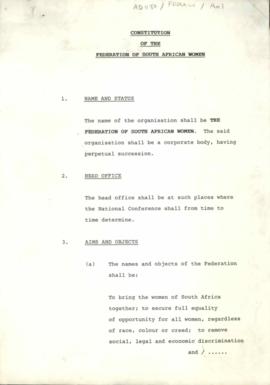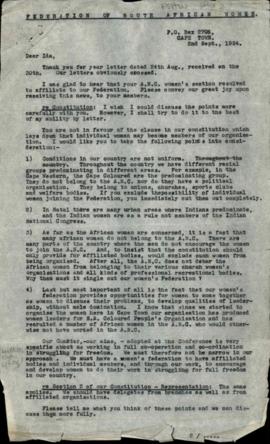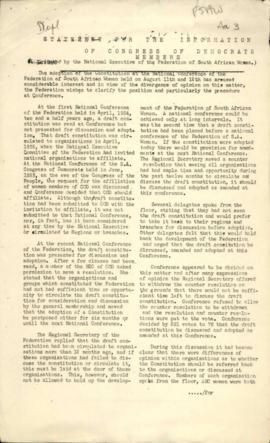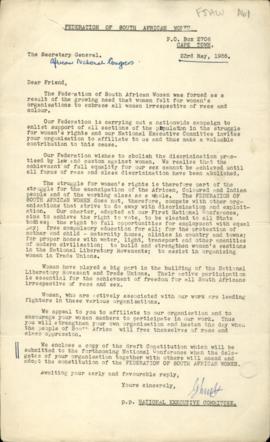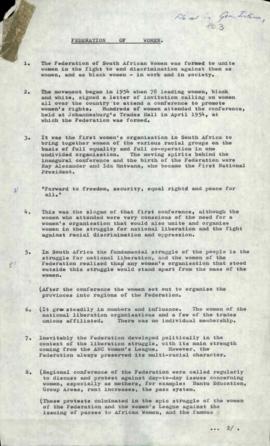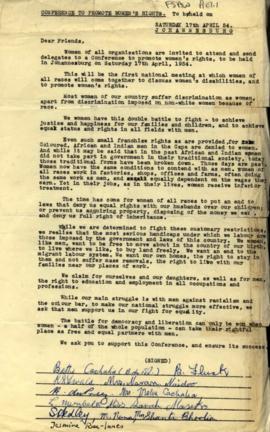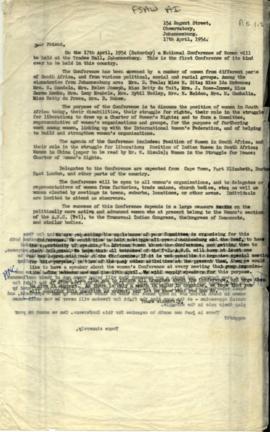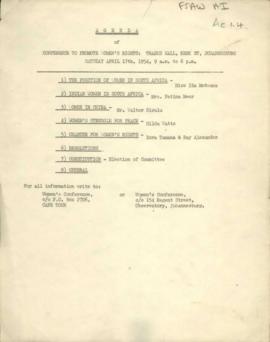Identity area
Reference code
Title
Date(s)
- 1953 - 1963 (Creation)
Level of description
Fonds
Extent and medium
Extent1184 items
Context area
Name of creator
Administrative history
The Federation of South African Women (FEDSAW) was formed at the "First National Conference of Women" as the inaugural conference was called, held in the Trades Hall, Johannesburg on 17 April 1954. This meeting was the culmination of months of planning, having been first suggested at a conference held in Port Elizabeth in April 1953, which was an informal meeting of women, trade unionists and African National Congress members to which Ray Alexander had been invited. She, from her home in Cape Town, assisted by Hilda Watts in Johannesburg, organised the inaugural conference. Both women had been members of the Communist Party of South Africa before its banning in 1950 and had widespread contacts amongst women of various organisations.
There were close on 150 delegates representing 230,500 women at the inaugural conference and they came from all over South Africa and from a wide cross-section of women of all colours, although mainly Black. They were drawn mostly from the Congress Alliance, made up of the African National Congress, South African Indian Congress, South African Congress of Democrats, South African Coloured Peoples Organisation and trade unions which left the Trade Union Congress of South Africa and formed the South African Congress of Trade Unions in 1955. The conference adopted a Women's Charter which included these words "We women have stood and will stand shoulder to shoulder with our menfolk in a common struggle against poverty, race and class discrimination". A draft constitution was drawn up stating the aims and objects of the Federation as being "To bring the women of South Africa together, to secure full equality of opportunity for all women, regardless of race, colour or creed; to remove social and legal and economic disabilities; to work for the protection of the women and children of our land". There was some debate as to whether the Federation should provide for individual membership but this point was settled in 1956 when the National Conference voted in favour of the Federation consisting only of affiliated organisations and no individual members.
By 1957 the following organisations had affiliated: African National Congress Women's League, South African Congress of Democrats, South African Coloured Peoples Organisation, Cape Housewives League, League of Non-European Women (Cape), Transvaal Indian Congress for Women and the Food and Canning Workers' Union. The Federation grew into a massive organisation which played its part in the national struggle for liberation and was involved in the convening of the Congress of the People by the Congress Alliance at Kliptown on June 25-26, 1955, at which the Freedom Charter was adopted. FEDSAW led the great protest against the extension of passes to African women in the 1950s, the most important event in this campaign being the mass gathering at Pretoria on 9 August 1956, thereafter observed as "Women's Day" during which 20,000 women stood in silence for 30 minutes after presenting their petition. It was on this occasion that they sang "Strijdom, you have tampered with the women/ you have struck a rock/ you have unleashed a boulder/ you will be crushed", later to be adopted as an anthem. This was followed by several demonstrations in 1957 and 1958. Other campaigns protested against Bantu education, beerhalls, Group Areas, discrimination in the nursing profession, rent increases and basic community problems. They supported the boycott of the Union Festival in 1960 and the stay away from the Republic celebrations in 1961. In 1962 they tried to draw up a Bill of Women's Rights.
From the very beginning the Federation suffered from the fact that, although as an organisation it was never banned, the leaders - Ray Alexander, Hilda Bernstein, Lilian Ngoyi, Frances Baard, Helen Joseph, Dorothy Nyembe, Amina Cachalia and Albertina Sisulu were and so were its affiliates, the African National Congress Women's League and the women's branch of the South African Congress of Democrats. The Federation was weakened by the Treason Trial of 1956-1961 and some members were detained during the state of emergency which followed Sharpeville in 1960. For a few years they struggled on under difficult circumstances but the last conference of any size took place in August 1962. Thereafter it went into rapid decline as more and more women were either banned, house-arrested or left the country. By the mid-1960s it had ceased to exist as a viable, mass-based organisation. It was never dissolved and, from time to time, the members attended historical funerals wearing their black and green uniforms.
In the early 1980s there was an attempt to revive the Federation. A 30th birthday celebration meeting was held in Mamelodi on 9 August 1984. On the 2 August 1986 a national assembly of women was held, followed a week later by a prayer service to celebrate the 30th anniversary of the march to Pretoria to protest against passes for women. Grassroots organisations were formed, including the Federation of South African Transvaal Women (FEDTRAW) in the Transvaal in December 1984, and others were formed in the Eastern and Western Cape, Natal and the Orange Free State.
In the Transvaal an interim committee was formed, an open day held on 1 June 1987 which included speakers from the old executive of FEDSAW and newsletters were published. In the Western Cape there was a regional launch in August 1987. Women demanded an end to conscription, a free equal educational system for all and the total abolition of apartheid. Further repression followed during the state of emergency and it was not until 1990 that women were free to demonstrate openly. In the intervening 30 years times had changed and many women had other loyalties than to FEDSAW. There had been a division in the ranks as not all women could subscribe to a total redistribution of wealth as demanded by some organisations. Many women preferred to join organisations like the African National Congress Women's League. As a national organisation FEDSAW has not been resurrected.
Archival history
The records of the Federation of South African Women (FEDSAW) were originally part of the archives of the South African Institute of Race Relations and were transferred to the Department of Historical and Literary Papers of the Library in 1978 by the Institute's archivist, the late Jeanette Curtis (Mrs Marius Schoon) who was assassinated in Angola in 1984. She gave them to the library for safekeeping to ensure their survival as she was detained and banned. At the time she maintained that some of FEDSAW's records had been seized by the security police. Certainly the collection is incomplete, but, despite this fact, very valuable as an insight into the part played by women in the struggle for sexual equality and the wider struggle for racial equality in South Africa.
Immediate source of acquisition or transfer
Content and structure area
Scope and content
The following abbreviations have been used:
ANC - African National Congress.
FEDSAW- Federation of South African Women.
NEC - National Executive Committee.
SACOD - South African Congress of Democrats.
SACTU - South African Congress of Trade Unions.
This inventory has been edited by the undersigned who supplied an index of all personal names mentioned in the inventory and of selective subject fields together with a brief history of FEDSAW.
Appraisal, destruction and scheduling
Accruals
System of arrangement
The original arrangement and classification of the records and the compilation of an inventory was carried out by Miss Curtis. Subsequently, the inventory was revised by Desiree Patel (nee Soudien), one of the staff of the Department of Historical Papers, to bring it into line with the style used for compiling inventories. The broad divisions were retained but some re-classification within the categories took place. At first sight it is puzzling to find Congress Alliance material included in FEDSAW's records but this is explained by the very close association between FEDSAW and the bodies which made up the alliance.
Conditions of access and use area
Conditions governing access
Conditions governing reproduction
Copyright Historical Papers Research Archive, The Library, University of the Witwatersrand, Johannesburg, South Africa
Language of material
Script of material
Language and script notes
Physical characteristics and technical requirements
Finding aids
Uploaded finding aid
Allied materials area
Existence and location of originals
Existence and location of copies
Related units of description
Notes area
Note
The digitisation of this collection has been made possible with generous funding from the Atlantic Philanthropies Foundation.
Alternative identifier(s)
Access points
Subject access points
Place access points
Name access points
Genre access points
Description control area
Description identifier
Institution identifier
Rules and/or conventions used
Status
Level of detail
Dates of creation revision deletion
Language(s)
Script(s)
Sources
Archivist's note
Compiled by Desiree Y. Patel
Edited by Anna M. Cunningham, 1992


